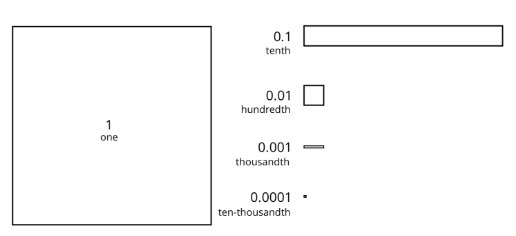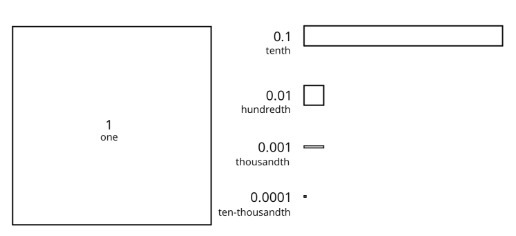What number does the rectangle represent if each small square represents 1.
Problem Set "Student Facing Tasks---6.5 Lesson 2: Using Diagrams to Represent Addition and Subtraction (6.NS.B.3)"
Problem 1
Here is a rectangle.
What number does the rectangle represent if each small square represents 0.1.
What number does the rectangle represent if each small square represents 0.01.
What number does the rectangle represent if each small square represents 0.001.
Problem 2
Here is a square.
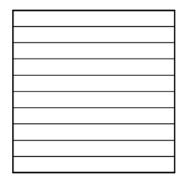
What number does the square represent if each small rectangle represents 10.

What number does the square represent if each small rectangle represents 0.1.
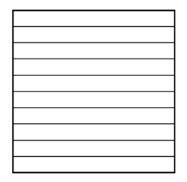
What number does the square represent if each small rectangle represents 0.00001.
Problem 3
- A large square represents 1 one.
- A medium rectangle represents 1 tenth.
- A medium square represents 1 hundredth.
- A small rectangle represents 1 thousandth.
- A small square represents 1 ten-thousandth.
You may be familiar with base-ten blocks that represent ones, tens, and hundreds. Here are some diagrams that we will use to represent base-ten units.
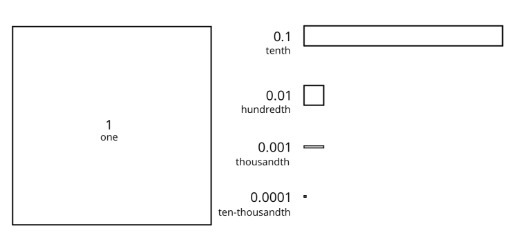
Here is the diagram that Priya drew to represent 0.13.
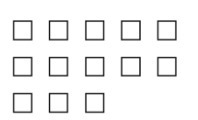
Draw a different diagram that represents 0.13.
Submit your diagram using the tools below.
Explain why your diagram and Priya's diagram represent the same number.
Problem 4
- A large square represents 1 one.
- A medium rectangle represents 1 tenth.
- A medium square represents 1 hundredth.
- A small rectangle represents 1 thousandth.
- A small square represents 1 ten-thousandth.
You may be familiar with base-ten blocks that represent ones, tens, and hundreds. Here are some diagrams that we will use to represent base-ten units.
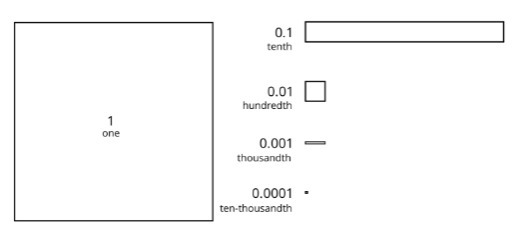
Here is the diagram that Han drew to represent 0.025.
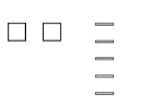
Draw a different diagram that represents 0.025.
Submit your diagram using the tools below.
Explain why your diagram and Han's diagram represent the same number.
Problem 5
- A large square represents 1 one.
- A medium rectangle represents 1 tenth.
- A medium square represents 1 hundredth.
- A small rectangle represents 1 thousandth.
- A small square represents 1 ten-thousandth.
You may be familiar with base-ten blocks that represent ones, tens, and hundreds. Here are some diagrams that we will use to represent base-ten units.
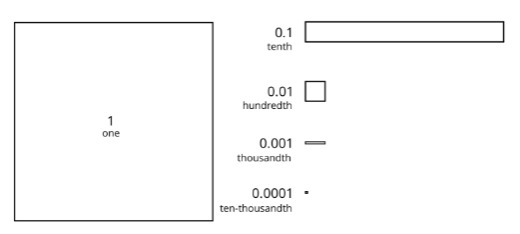
For the number below, draw or describe two different diagrams that represent it.
0.1
Submit your work using the tools below.
For the number below, draw or describe two different diagrams that represent it.
0.02
Submit your work using the tools below.
For the number below, draw or describe two different diagrams that represent it.
0.004
Submit your work using the tools below.
Problem 6
- A large square represents 1 one.
- A medium rectangle represents 1 tenth.
- A medium square represents 1 hundredth.
- A small rectangle represents 1 thousandth.
- A small square represents 1 ten-thousandth.
You may be familiar with base-ten blocks that represent ones, tens, and hundreds. Here are some diagrams that we will use to represent base-ten units.
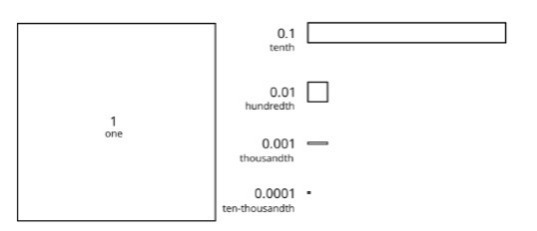
Use diagrams of base-ten units to represent the sum below. Think about how you could use as few units as possible to represent the number.
Use diagrams of base-ten units to represent the sum below. Think about how you could use as few units as possible to represent the number.
0.006 + 0.007
Use diagrams of base-ten units to represent the sum below. Think about how you could use as few units as possible to represent the number.
0.4 + 0.7
Problem 7
Here are two ways to calculate the value of 0.26 + 0.07. In the diagram, each rectangle represents 0.1 and each square represents 0.01.
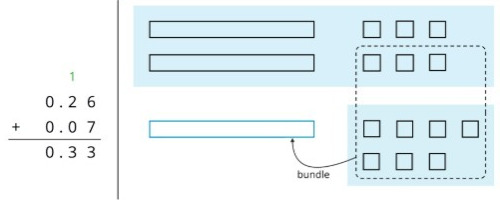
Use what you know about base-ten units and addition to explain why ten squares can be “bundled” into a rectangle.
Use what you know about base-ten units and addition to explain how this “bundling” is reflected in the vertical calculation.
Problem 8
Draw a diagram.
0.38 + 0.69
Submit your diagram using the tools below.
Based on your diagram, find the value of 0.38 + 0.69.
Can you find the sum without bundling? Would it be useful to bundle some pieces? Explain your reasoning.
Problem 9
Calculate 0.38 + 0.69.
Check your calculation against your diagram in the previous question.
(Previous question: 0.38 + 0.69)
Problem 10
Find the sum. The larger square represents 1, the larger rectangle represents 0.1, the smaller square represents 0.01, and the smaller rectangle represents 0.001.
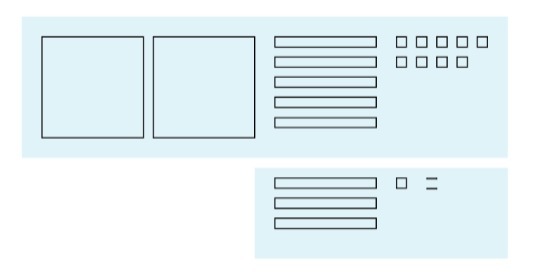
b.

Problem 11
A distant, magical land uses jewels for their bartering system. The jewels are valued and ranked in order of their rarity. Each jewel is worth 3 times the jewel immediately below it in the ranking. The ranking is red, orange, yellow, green, blue, indigo, and violet. So a red jewel is worth 3 orange jewels, a green jewel is worth 3 blue jewels, and so on.
If you had 500 violet jewels and wanted to trade so that you carried as few jewels as possible, which jewels would you have?
Suppose you have 1 orange jewel, 2 yellow jewels, and 1 indigo jewel. If you’re given 2 green jewels and 1 yellow jewels, what is the fewest number of jewels that could represent the value of the jewels you have?
Problem 12
Here is a diagram that represents differences. Removed pieces are marked with Xs.
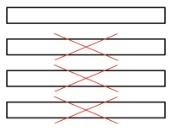
Determine the value of the expression.
Problem 13
Here is a diagram that represents differences. Removed pieces are marked with Xs.

Determine the value of the expression.
Problem 14
Here is a diagram that represents differences. Removed pieces are marked with Xs.

Determine the value of the expression.
Problem 15
Express the subtraction in words.
0.05 − 0.02
Express the subtraction in words.
0.024 − 0.003
Express the subtraction in words.
1.26 − 0.14
Problem 16
Find the difference by drawing a diagram.
0.05 − 0.02
Submit your diagram using the tools below.
Find the difference by calculating with numbers.
Do the answers from both methods match?
If not, check your diagram and your numerical calculation.
Problem 17
Find the difference by drawing a diagram.
0.024 − 0.003
Submit your diagram using the tools below.
Find the difference by calculating with numbers.
Do the answers from both methods match?
If not, check your diagram and your numerical calculation.
Problem 18
Find the difference by drawing a diagram.
1.26 − 0.14
Submit your diagram using the tools below.
Find the difference by calculating with numbers.
Do the answers from both methods match?
If not, check your diagram and your numerical calculation.

